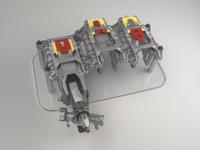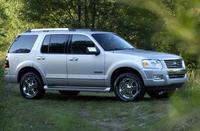2006 Ford Explorer Review
 2006 Explorer's adaptive "curl strap" that deforms as force is applied, acting as a damper to slow the stroke of the steering column. |
Bit Byte: Ford spent its development resources wisely; the 2006 Explorer is a terrific successor to America’s most popular SUV.
By Thom Cannell
Detroit Bureau
SEE ALSO: New Car Buyer's Guide for Ford
In August, TACH provided you with an in-depth examination of virtually every aspect of the all-new Ford Explorer including model lineup, powertrain variations, options, and even color schemes. That’s everything, everything but a report of what it’s like to drive this new-for-2006 SUV. Will this Explorer live up to its claims of superiority? Does the new Explorer transcend previous versions and deliver value for your hard earned dollar. In one word, yes. In many words…
Road tripping the 2006 Explorer
We flew to Lake Placid, New York, site of the 1932 and 1980 Winter Olympics and immediately spent 90 minutes driving 2005 Explorer SUVs.
2005 Explorers drive well. Steering is light and direct, with plenty of road feel and the Triton V-8 provides sufficient power for almost every need. The interior is also functionally designed, handsome, and reasonably quiet. What improvements would this new model bring?
Pausing for technical briefings—the gory details are exhaustively reported in our earlier story—we collected pilot versions of the 2006 Explorer and set out on nearly 300 miles of mixed highway, secondary, and rutted two-track driving. Ford delivered the roughest “off road” route in recent memory, one that would expose any faults quicker than Tyra Banks sonogram.
Immediately, my driving partner and I noticed the resemblance of our Explorer Limited’s cabin to the new F150. It has a similar center console, console-mounted shifter, and dashboard. The dash has the same vertically flanked sides as F150 and similar instrument panel opening. Explorer uses twin circular gauges, large and white faced, with easy to read numerals. Missing are the trucks’ isolated gauges; Explorer has only built-in fuel and water temperature with warning lights for other functions.
We appreciated the steering wheel-mounted controls for cruise control, temperature, and audio (6-CD/AM/FM.) Our Limited was equipped with adjustable pedals, a DVD-based navigation system, and had “wooden” accents. For a faux-finish, the wood is quite convincing, even in direct sunlight.
Once underway, this Explorer was quiet as a deserted campground — quieter than the 2005 model and most sedans. There are several reasons, including denser carpeting with an improved backing that’s 13 fuel-saving pounds lighter. (Beneath most automotive carpets is a dense, black asphalt-like sound absorption material, and cotton padding.)
Behind door panels and dash is another sound absorber that resembles thin black fiberglass insulation, and a similar sound dampener is sandwiched between roof and headliner. So Ford’s claim of unequalled quiet for front seat passengers rings true. No matter how bad the road surface, and we’re talking about 50 mph over ruts, gravel and rocks, the interior remained luxury-car quiet. At 75 mph on the highway, this SUV was quieter than a Jaguar X-type!
Ford also promises that third-seat passengers have an environment quieter than most competitors’ front seats. In other words, it will be easier than ever to hear “Are We There Yet?”
Explorer uses a clean-burning 210 horsepower 4.0-liter V6 or a more powerful 292 horsepower 4.6-liter V8. The V6 mates to a five-speed automatic while the V8 receives an all-new six-speed automatic. Either powertrain uses a 3.55:1 final drive and towing power is respectively 5390 lbs./7300 lbs.
Explorer’s frame, including the unique “porthole” independent rear suspension introduced on previous Explorers, is all-new.
A typical truck chassis resembles a ladder with a box or three on top and most full-sized SUVs and medium and full sized pickups use this body-on-frame construction. By welding every rung in the ladder to, and through its box-section frame rails, Ford achieves significantly improved strength. The freedom to optimize body and chassis separately gives engineers maximum design flexibility. For instance, to have a flat rear load floor plus reasonably wide third row seats, Ford increases the vertical height of a portion of the rear frame tube, punches a hole through and fills it with a welded-in steel tube. The axle shafts go through this opening; it allows the independent rear axles to move up and down.
But what does that mean to you? Isolating the frame from the body on natural and synthetic rubber cushions helps quietness. A stiff frame lets engineers pick the best spring rate for controlling body motion, the best “shock absorber” rate, and pick tires designed for a mix of comfort and precision. For the driver, the result is steering precision, directional stability, and comfort.
On the day we drove the roads around Lake Placid, bikers and runners were training for an Ironman Triathlon; Ford is the title sponsor. I lost count of the times a biker would appear around a blind corner. Maneuverability, braking, and directional stability were necessary to avoid the brightly clad participants. That actually made driving more fun.
As the roads became rougher—secondary paved roads, gravel rural roads, and finally miles and miles of two-track—it didn’t get much louder inside the cabin. Mind you, we were traveling at over 30 mph and kicking up gravel and bouncing about on stones that varied from golf balls to the occasional bowling ball-sized rock.
Ford’s efforts to resist head toss, an aptly descriptive term, made our rough road driving a comfortable experience. In less sophisticated SUVs your head is tossed about like pins at a bowling alley. Explorer exhibits a very minimal amount.
Fords venture into electronic mapping and navigation presented a mixed blessing throughout our trip. Roads are displayed as colored spaghetti strands, which was kind of hard to follow. Other navigation systems use much thicker representations at the same scale. However, atop Explorer’s display is the name of the road traveled, even dirt two-tracks had names. Thus we always knew we were on, or off, the planned route. Plus it would announce upcoming turns by name. Not just “right” but “right on McGregor Avenue.”
Musically, the stereo /DVD entertainment center is impressive. Does your sound system permit three audio sources: front passengers listening to the radio, second row guests headphone-connected to a movie, and the kids in back listening to a CD?
I had one small complaint, the steering felt a bit too compliant. That is, a tiny bit soft when directions change. We discovered this was likely due to my aggressive driving and the 18” Michelin tires (P235/65R18) and 18 x 7.5 in. wheels chosen for grip and ride quality. Some of that quietness and comfort represents a compromise. If you prefer the steering precision Explorer has always exhibited, the 17” BFG tire (P245/65R17) is specified for markets where the vehicle is driven at 80+ MPH speeds on rough roads.
“Tires make a difference,” said Chris Brewer, Explorer Engineering Manager said to me. “Some offer more ride compliance; not everyone wants to go around every turn at twice the suggested speed.” Guilty as charged, Chris.
Safety
Explorer engineers and designers are justifiably proud of its advanced safety features. Beyond familiar ABS and four-wheel disc brakes, dual-stage front air bags, driver seat position sensor, pre-tensioning seat belts, and crumple zones designed to crush and absorb energy, are new features that require explanation.
Seat belts now adapt to occupant size and crash severity, they allow tension, then limited forward motion. Front seats recognize five categories of passenger: none, child, small adult, medium adult, large adult. This information is part of the adaptive seat belts, and instructs dual-stage airbags how much cushion is needed (the passenger’s airbag has a fabric tether that can keep the airbag small when needed.) Airbags also incorporate adaptive venting to adjust the size and deflation of each airbag.
The “Adaptive Stroking Steering Column” is very cool, and more than a little weird. The photo shows three possibilities for this device, which permits the steering wheel to move forward as much as 4” (100 mm) to absorb crash energy. By deforming as energy is absorbed (your body pushing into the airbag and steering column—like a stunt man falling onto a stack of cardboard boxes,) the “curl strap” acts as a force absorber.
Smaller adults, women in particular, are apt to be seated closer to the steering wheel, so less force absorption is needed. For unbelted drivers—you always buckle up, right?—the steering column would not move to keep the air bag nearer your chest.
If belted, the Stoking Steering Column might move away and allow the seat belt and air bag to offer protection. If it sounds complex, it is. In fact, with dual stage air bags, the very shape of the air bag can be changed to offer the kind of energy absorption necessary.
Most drivers are familiar with electronic stability controls that measure rotational forces. Ford calls theirs AdvanceTrac™ and it tries to prevent oversteer and understeer, called yaw or rotation. As SUVs have a higher center of gravity, Ford offers Roll Stability Control that anticipates and tries to overcome events that indicate impending rollover. If you’re having trouble, think of a roller skate: push sideways against the rear wheels. That slide parallel to the floor is oversteer. Push perpendicular to the front wheels and it’s understeer. But push the top of the skate boot to make it fall over—that’s the roll angle RSC measures.
As nothing can prevent some rollovers, Ford was one of the first SUVs with a full length curtain air bag—Safety Canopy™—for roll-over and some side impact events. For 2006 it’s improved with wider and taller inflation zones, and if a passenger is resting their weary head against a window, the “roll-fold” technology will slide between head and glass. For 2006 there are also side-impact air bags for front seats.
For aggressive drivers, or those who regularly drive on dirt, Explorer allows some wheel slip, some body motion, but not too much. When driving quickly on loose gravel, the rear end can and will oversteer a bit before the system is triggered. That’s nice because some slip is, and feels natural, while an over zealous stability control system will kick in too aggressively, which is very disconcerting.
When you drive an Explorer you’ll agree that Ford spent its development resources wisely; the 2006 Explorer is a terrific successor to America’s most popular SUV. It is a go-anywhere vehicle with a living room-quiet environment more elegantly finished than many homes.
Despite rising gasoline prices, Explorer makes sense for families and people who need comfortable seating for 2-8 people—no one else offers a power folding third row seat—and the ability to tow a very sizeable boat or trailer. Perhaps most importantly, none of its fun to drive anywhere, any time, spirit has been lost. That has improved, even as Explorer became safer and more trustworthy.



